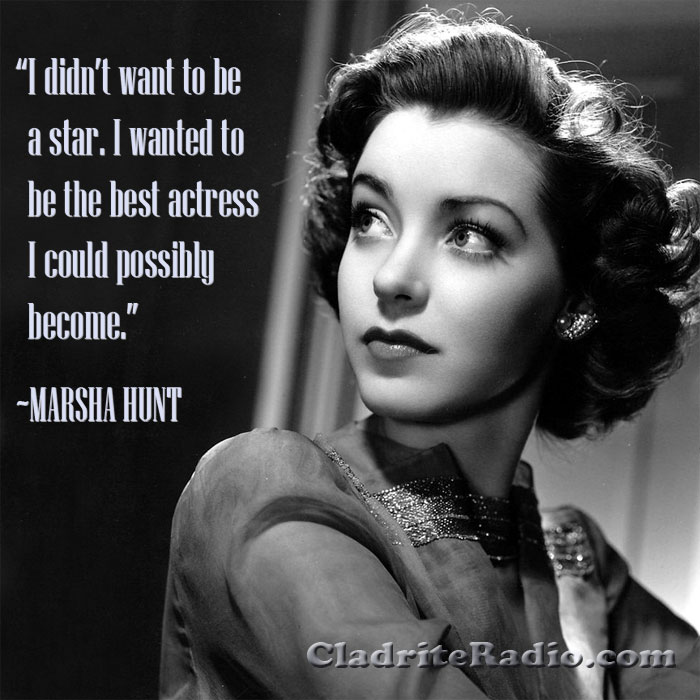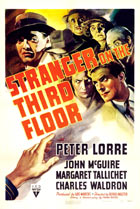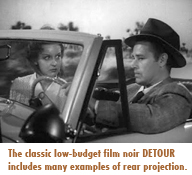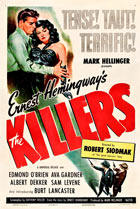Here are 10 things you should know about Claire Trevor, born 112 years ago today. An Oscar winner, she enjoyed success on stage, in pictures, in radio and on television.
Tag: Raw Deal
Happy 99th Birthday, Marsha Hunt!
The lovely Marsha Hunt, born Marcia Virginia Hunt in Chicago, Illinois, is celebrating her 99th birthday today! Here are some MA Did-You-Knows:
- The daughter of an attorney and voice teacher, Hunt and her family moved to New York City when she was three years old. She took an interest in performing at an early age, appearing in school plays and performing at church functions.
- After graduating from NYC’s Horace Mann High School (at age 16!), she worked as a model and as a singer on the radio while studying drama at the Theodora Irvine’s Studio of the Theatre (where Cornel Wilde was one of her classmates)
- At 17 (and accompanied by her older sister), Hunt moved to Hollywood to pursue a career in motion pictures. She was quickly signed by Paramount Pictures and in 1935 made her debut in The Virginia Judge. She was relegated to mostly B pictures at Paramount and when her career failed to take off, she began to freelance at various studios, including many of the Poverty Row outfits.
- In 1939, Hunt signed with MGM, where she was given solid parts but rarely lead roles. Her association with MGM came to an end in 1945 and she began freelance again (it was during this period that she appeared as the “good girl” counterpart to Claire Trevor‘s “bad girl” in Anthony Mann‘s classic film noir Raw Deal (1948).
- In 1948, Hunt decided to give Broadway a try, debuting in Joy to the World. She appeared in a number of other shows as well, including a turn as Anna in a production of The King and I. She also appeared on Broadway with Johnny Carson, in a production called Tunnel of Love.
- Hunt was a lifelong liberal and in the early 1950s, some of her past political activities unfairly came back to haunt her. Although she was never called to testify before the House Un-American Activities Committee, her name appeared in the infamous Red Channels pamphlet that purported to expose Communists and other subversives in the radio and television industries. She made just three films in the next eight years.
- Semi-retired thereafter, Marcia has devoted herself to humanitarian causes and organizations, among them UNICEF, The March of Dimes and The Red Cross.
- Hunt was named the honorary mayor of Sherman Oaks, California, in 1983 and still holds that “post” today.
- In 1993, Hunt published a book on fashion entitled The Way We Wore.
- In 1998, Hunt received the Eleanor Roosevelt Humanitarian Award for her charitable and humanitarian activities.
Happy birthday, Marsha Hunt, and many happy returns of the day!

Poster art for art's sake
Like many movie buffs, we find ourselves drawn to the motion pictures of yesteryear more than those of today. Not there aren’t terrific movies made today—there certainly are—but so many current films are aimed at teenagers of all ages. As author Stefan Kanfer states in his recent biography of Humphrey Bogart, Tough Without a Gun: The Life and Extraordinary Afterlife of Humphrey Bogart, “Today, young viewers constitute some 70 percent of the filmgoing audience.” Of course, the question many movie buffs would ask is, “Which came first, the predominantly youthful audience or the movie industry that caters almost exclusively to them?” Not that it much matters. What’s done is done, and the situation isn’t likely to change in the near future.
But it’s not just movies that too often don’t stack up today. Movie posters have become so pedestrian as to be almost invisible. Honestly, when was the last time you really were taken by a movie poster, stopping to admire it on its own terms, quite apart from your interest (or lack thereof) in the picture it was advertising?
Too many contemporary movie posters feature no artistic touches whatsoever, just poorly Photoshopped scenes that too often appear as if the actors featured were not even in the same room when the shot was taken.
It wasn’t always so. Prior to 1960, movie posters were the work of artists, and they provided a pleasure all their own.
The man behind the blog Where Danger Lives, a college professor in Pennsylvania, understands the appeal of old movie posters. He recently posted his favorite 100 film noir posters (a genre for which we share an avid affinity with Mr. WDL). A few of the posters he chose tout movies we don’t consider to be film noir, but that’s picking nits. We’ll share a handful of the posters below and encourage you to visit Where Danger Lives to see the rest. Mr. WDL offers interesting insights on the design of the posters, but even if you’re not interested in what makes the posters “work,” from a designer’s point of view, the images themselves are well worth the click.




